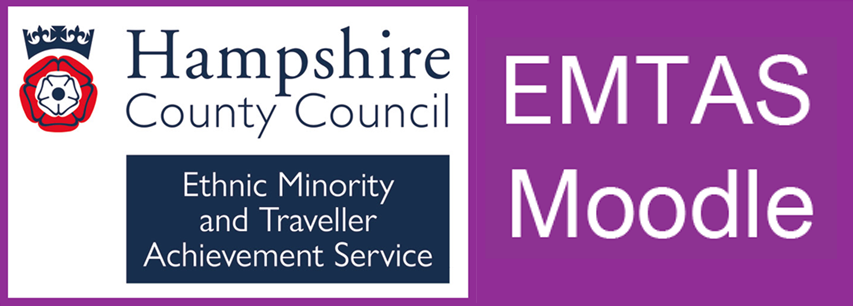Blog entry by Astrid Dinneen
Anyone in the world
By Hampshire EMTAS Team Leader Sarah Coles and Astrid Dinneen, EMTAS Specialist Teacher Advisor for schools in Basingstoke & Deane

With the increase in numbers of children joining our schools from overseas with very little English, practitioners in schools are asking how best to proceed. Should they first focus on teaching the children English or is there another approach?
EAL best practice tells us that the best thing to do for such children is to include them in the full mainstream curriculum being delivered in schools via the medium of English. This can be scaffolded in various ways. The children should not be withdrawn to be taught English separately or as a prerequisite to being allowed to join their peers in regular lessons. But this immersion approach can seem an alarming response; surely the children will not be able to understand anything and will flounder and fail, people may think. So instead some opt for an ‘English first’ approach. They buy in an online English teaching app or print off worksheets for the children to learn the days of the week and the colours in English whilst their peers are learning about how plants grow or the story of The Titanic or Shakespeare’s Hamlet.
The problem with the English first approach is that far from helping, it actually slows down the children’s progress in their acquisition of English, as well as making it harder for them to feel welcomed and included in the life of their new school. Plus it adds to teachers’ workloads; now they are having to source materials for an entirely separate curriculum as well as plan for the rest of their class.
To illustrate this in more detail, consider these two
approaches for the same newly arrived child whom we shall call Hatice*. Assume Hatice
is new to English (Bell Foundation EAL Assessment Framework Band A, to those in
the know) and literate in Turkish.
Scenario 1: English first
The teacher decides to plan separate provision for Hatice, because they feel their mainstream English lesson is too challenging for Hatice’s level of English. So whilst the other children are preparing to write a letter persuading their Head Teacher to shift the start of the school day back by an hour so they start at 10.00 instead of at 9.00, Hatice will sit on her own and work through some sheets that focus on learning the English words for some colours and common classroom objects. In one example below Hatice is required to draw and colour the correct classroom object in the empty box.
It is a…
|
red |
pen.
|
|
purple |
book.
|
|
|
orange |
chair.
|
|
Fortunately, Hatice is compliant, meaning the teacher can get on with teaching the rest of the class. Hatice spends the whole morning working on these worksheets on her own. She doesn’t disrupt anyone but the teacher notices that she regularly has her head down on the desk and appears to be dozing.
At the end of a couple of weeks at school, Hatice is still very much on the periphery of things in the classroom and needs frequent reminding when she is included in instructions given by the teacher, for example when it’s time to get ready for PE or line up to go to assembly. She spends long periods of time gazing out of the window and generally seems to lack motivation and enthusiasm for anything other than home time.
There has also been a deterioration in her output and she
now very rarely completes the worksheets she is given. Where she has had a go with
tasks that require writing, her handwriting is much less tidy and it seems she is
taking increasingly less care over her work.
With regards to friendships, it seems to be still very early days and Hatice has not formed any strong relationships with her peers. She continues to spend most of her time at break and lunch times on her own.
Her teacher reflects on practice and provision so far. It has
taken a lot of time planning, resourcing and marking the worksheets for Hatice,
yet she does not seem to be making progress. He is not sure what else to do but
feels this is not a sustainable approach in the long term. He is interested in
finding out about alternatives…
Scenario 2: immersion using EAL-friendly strategies
Hatice’s teacher plans to include her in the lesson along with everyone else from the get-go. First off, before the series of lessons begins, the teacher sends Hatice home with a list of words in English to be translated into Turkish with the help of parents. He asks them to talk to Hatice about the concept of ‘persuasion’; what does the word itself mean and in what in real life scenarios might we use persuasion to get the outcome we desire? The teacher recommends the family use a translation tool like Google Translate to help them to do this:
English word/phrase |
Turkish (Türkçe) |
Persuade (someone to do something) |
ikna etmek |
We think |
düşünürüz |
Benefit |
|
Consider |
|
Because |
|
Late/later |
|
Traffic |
|
Drawback |
|
Ensure |
|
Potential |
|
The words the teacher chooses for this are drawn from a model letter which will be used in the lesson the following day. The teacher chooses to write the model himself to incorporate the language of persuasion, different persuasive techniques and ideas already suggested by the children themselves. At other times, he might have used ChatGPT to generate a model in no time.

Having diligently completed her pre-learning at home with
the help of her parents and discussed the concept of persuasion in Turkish, Hatice
is very proud to bring in a dual-language glossary she has started in her
special book. She places it on her desk
next to her pencil case. Her new buddies seem to be taking an interest in the
stickers she has stuck on her book and this adds to her feeling of pride.
She is also pleased to recognise the vocabulary she has researched and translated in a handout placed on her desk by her teacher. Everybody else is given the same handout. Hatice is intrigued and delighted to see she might not be doing different work today. Plus a Teaching Assistant approaches her holding a tablet and shows her how to scan the text to translate it into Turkish. Hatice smiles and chuckles as she reads the translation and discovers the text is a letter asking their head teacher to delay the start of the school day.
Highlighters are distributed and her buddies start a conversation. They’re highlighting parts of the letter. Hatice checks the tablet to see the translation again and tries to match the highlighted text to the translation. She starts to neatly annotate her letter in Turkish. Her teacher looks happy so she continues her annotations and adds to her dual-language glossary words such as ‘firstly’, probably’, ‘clearly’ etc. Her buddies highlighted them so Hatice thinks they must be important.
Later on, the children are to write their own letter using
features of the original. Hatice’s teacher suggests to her that she could write
her letter in Turkish. Hatice happily engages with this, writing fluently and
at length, sometimes self-correcting and adding punctuation. She writes in
paragraphs and her sentence starters seem to vary. She even attempts to
incorporate some English vocabulary eg ‘firstly’ and ‘clearly’. This reassures Hatice’s
teacher who can see she has lots of ideas and things to say. He notices Hatice
sometimes looks at her peers’ writing - both are quite happy to show her their
work – and is making use of the tablet to communicate with them using translation
apps.
What now?
Experimenting with EAL pedagogy has proved promising as it’s meant Hatice has felt included, motivated and able to meet curriculum objectives in a differentiated way. Her teacher would like to build on this by trying other EAL strategies such as substitution tables and Dictogloss, planning further opportunities for listening and speaking and continuing the use of Turkish as a tool for learning. To explore these further why not join one of our online network meetings?
EMTAS
training courses | Hampshire County Council (hants.gov.uk)
*This child's name is pronounced /hætidʒe/
[ Modified: Monday, 23 January 2023, 10:56 AM ]
